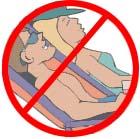A Healthy Tan?

I'll admit it up front: I have very pale skin, and gave up on tanning at an early age. When I was growing up, my friends slathered oil on their bodies and soaked up rays until their skin was a nice, healthy brown. The serious tanners even used aluminum foil reflectors to magnify the sun's rays. I got freckles, spots and sunburns, and tried to avoid getting too much sun. Now that we know more about the effects of sunlight on our skin, I'm reassured that staying out of the sun was the best thing I could have done for my skin.
The sunlight that we see, called the visible spectrum, is a tiny part of the larger family of electromagnetic (EM) waves. Human eyes see EM waves as light in colors ranging from violet through red. Just beyond the violet that we see is invisible ultraviolet (UV) light, which can damage the skin.

The sun is our main source of UV light exposure, and is also the only natural source of this light. Gamma rays from nuclear reactions, TV and radio waves, and infrared radiation are also members of the EM wave family. Anyone even slightly interested in the science of light should visit the University of Arizona's beautifully written Patterns in Nature web module.
There are three types of UV light, designated as UVA, UVB, and UVC. The earth's ozone layer prevents UVC light from reaching the earth. Light in the UVA range has wavelengths of 320 to 400 nm, while UVB waves are 290 to 320 nm in length. Sunburns are caused primarily by UVB radiation. UVA rays penetrate more deeply than UVB, and contribute to premature aging of the skin. Both UVA and UVB rays cause skin cancer.
![[sunburn graphic]](/sites/default/files/sunburn.jpg)
What is a sunburn, anyway? Technically, it's a swelling of the tiny blood vessels in the dermis and subsequent swelling and reddening of the dermal tissues. Many different cell types throughout the skin are damaged or changed when you get a sunburn. Even a mild sunburn temporarily decreases the ability of immune cells in the skin to fight infections.
But changes in skin cells also occur when UV light damage stops short of burning. Although skin that has been exposed to the sun may look fine, damage to the skin is clearly visible under a microscope. Some of the damaged cells will repair themselves, but over time sun exposure can result in skin that is leathery, sagging, wrinkled, and spotty. Since it can take 20-30 years for all of these changes to appear, it's easy to ignore the risks of sun exposure until irreversible damage has occurred.
Tanning is a direct response to injury from UV radiation. Exposure to UV radiation causes the skin to produce the pigment melanin, which provides some protection from sunburn. But melanin doesn't prevent unseen structural damage from occurring in the skin. Even people who never burn or have naturally dark skin aren't immune to sun-damaged skin.
How about tanning beds and sun lamps, which produce mostly UVA rays? Since UVA light doesn't generally cause sunburn, artificial tanning devices emitting UVA light were once deemed safe. Because of the link between UVA light and skin cancer, the Food and Drug Administration and the Centers for Disease Control and Prevention recommend that people avoid the use of tanning beds and sun lamps. The American Medical Association (AMA) and American Academy of Dermaology (AAD) go even further, urging that the sale and use of tanning equipment for non-medical purposes be banned.
On average, your lifetime chance of getting skin cancer is about 1 in 6. Exposure to UVA and UVB radiation in sunlight is responsible for most cases of skin cancer, including melanoma, the most deadly form of skin cancer. Since up to 80% of an average person's sun exposure is thought to occur before the age of 18, it's important to educate young people about the risks of sun exposure. A child who has one or two severe sunburn at an early age is at much greater risk of developing skin cancer later in life than a child who has never had a sunburn. Parents should take responsibility for minimizing their kids' sun exposure from a very early age.
Sun-induced skin cancers come in many types, from relatively innocuous keratosis (a pre-cancerous condition) to the potentially fatal melanoma. When detected early, many skin cancers are easily treated. Despite this, the AAD estimates that more than 7,000 Americans died of skin cancer in 1996.
Cancer, wrinkles, spots--what else can go wrong? Well, the UV rays from the sun affect your eyes as well as your skin, and can cause cataracts. Some people are actually allergic to the sun's rays. This condition is termed photosensitivity. Sufferers develop hives, blisters, or bumps, often in the same area after each exposure to the sun. Use of irritants such as perfumes and cosmetics may heighten a person's sensitivity to the sun. Even people who are normally not photosensitive may develop a reaction if they use certain common medications, such as antibiotics, birth control pills, antihypertensives, psoralens, immunosuppressive agents, nonsteroidal anti-inflammatory drugs, and many other compounds.
Yes, it does. But it takes just a little sun to get all of the vitamin D your body requires each day--far less sun than it takes to acquire a tan. People who drink milk fortified with vitamin D usually get their daily requirement from milk, not the sun.
There are a number of practical things you can do to minimize your exposure to UV radiation. Some practical suggestions:
- Stay inside when the sun's rays are strongest. Plan your activities before 10 AM and after 4 PM.
- Wear clothes such as broad-brimmed hats and long-sleeved shirts and pants that protect you from the sun.
- Protect your eyes by wearing sunglasses that shield your eyes from both UVA and UVB light.
- Use a good sunscreen with a minimum SPF of 15. Cover your skin thoroughly with sunscreen, re-applying when you swim or sweat. Sunscreen should be worn all year long--the sun emits UV rays in the winter as well as the summer. Clouds don't filter out UV light, so you should wear sunscreen on overcast days, too.
It's also a good idea to learn what your personal risk factors are for developing skin cancer. Light-skinned people are more likely to develop skin cancer than dark-skinned folks, although each skin type is at some risk. The AMA has a brief online skin cancer quiz that evaluates your skin type and exposure history and assigns an individual risk factor.
Don't despair-- you can always get your tan from a bottle. The sunless tanning concoctions of my childhood left unwary users with orange skin. But bottle tans are much more realistic now. A better solution may be to change your idea of what healthy skin looks like. Let your skin role model be Nicole Kidman, not the cast of Baywatch. Forego the tan today, and thirty years from now you will have a better chance of being a pale but unwrinkled grandmother. You'll even have a better chance to enjoy the grandkids, since your likelihood of succumbing to skin cancer will decrease.
Kate Traynor is a fabulous medical writer babe and mother of two boys. Plus also she's a friend of Lynn's. © 1999-2017 Kate Traynor, used by permission.
